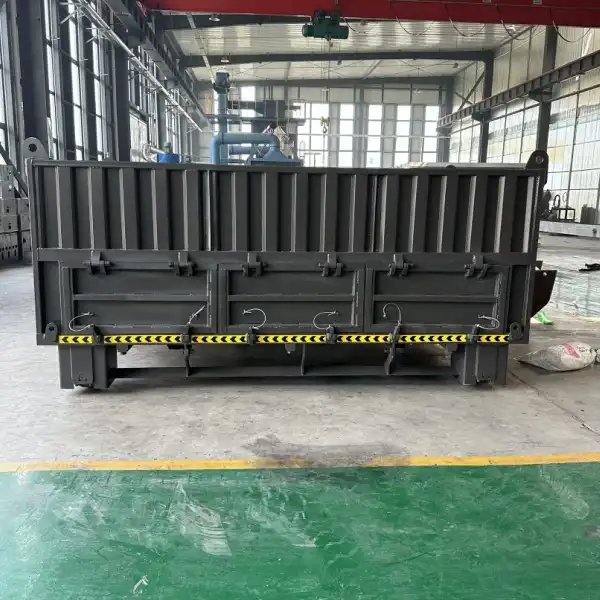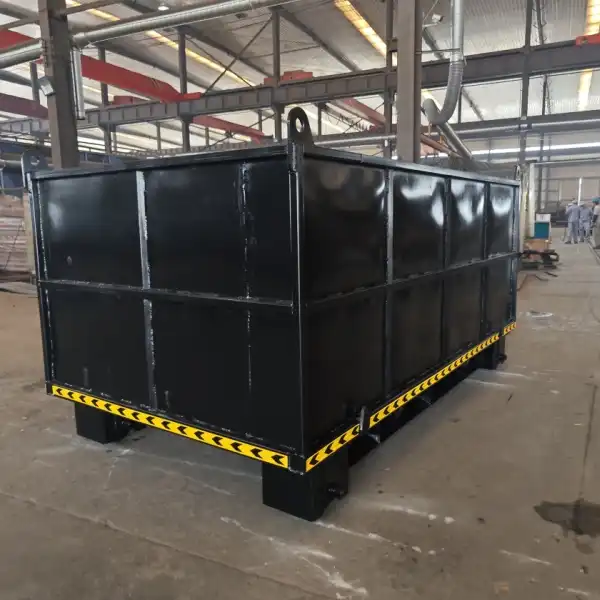What is the leakage method of railway ballast cars?
Railway ballast cars employ sophisticated leakage methods to ensure precise distribution of ballast material during track construction and maintenance operations. The primary leakage method involves railroad ballast car systems that utilize both side discharge and bottom dumping mechanisms to achieve optimal material placement. These specialized railway vehicles feature hydraulically operated gates and chutes designed to control the flow and distribution of crushed stone ballast across railway infrastructure. Modern ballast cars incorporate advanced control systems that enable operators to regulate discharge rates, ensuring uniform distribution while preventing material waste and maintaining construction efficiency. The leakage methodology directly impacts track stability, drainage effectiveness, and overall railway performance, making it crucial for construction teams to understand these fundamental distribution principles.

Leakage Of Ballast On Both Sides And At The Bottom
Side Discharge Mechanisms
Side discharge systems represent one of the most versatile approaches to ballast distribution in railway construction. Side dump cars are designed to deposit their load to either side of the tracks, rather than between the rails like a ballast hopper, providing operators with enhanced flexibility during material placement operations. These mechanisms utilize hydraulically powered gates positioned along the sidewalls of the ballast car, allowing controlled release of material to designated areas adjacent to the track structure.
The engineering behind side discharge involves careful consideration of material flow dynamics and distribution patterns. Operators can selectively open specific discharge points along the car's length, enabling targeted placement of ballast where needed most. This precision becomes particularly valuable when addressing specific track sections requiring additional support or when working around existing infrastructure elements that might obstruct traditional bottom-dump operations.
Bottom Dump Operations
Bottom dumping represents the traditional and most widely utilized method for ballast distribution across railway systems. These are bottom-dumping with hydraulically operated bottom gates that distribute it across the track section, and have bottom shoulder chutes to get the ballast past the tie ends. This approach ensures direct placement of material between rails and around tie structures, supporting optimal track geometry and stability.
The bottom discharge system incorporates multiple gate configurations that allow operators to control material flow rates and distribution patterns. Advanced ballast cars feature segmented bottom doors that can be operated independently, enabling selective discharge along different sections of the car. This granular control helps maintain consistent material thickness while accommodating varying track conditions and construction requirements.
Combined Discharge Systems
Modern railroad ballast car designs increasingly incorporate combined discharge capabilities that merge both side and bottom leakage methods into integrated systems. This dual-functionality approach provides construction teams with maximum operational flexibility, allowing them to adapt distribution methods based on specific site conditions and project requirements. Combined systems typically feature independent hydraulic circuits for each discharge mechanism, ensuring reliable operation and precise material control.
The integration of multiple discharge methods also enhances operational efficiency by reducing the need for multiple specialized vehicles on construction sites. Teams can accomplish comprehensive ballast placement using a single car type, streamlining logistics and reducing equipment costs while maintaining high standards of material distribution accuracy.
Uniformity Control: Avoiding Ballast Accumulation And Eccentric Loading
Distribution Pattern Management
Achieving uniform ballast distribution requires careful attention to discharge timing and gate operation sequences. Operators must coordinate multiple variables including train speed, gate opening intervals, and material flow rates to prevent accumulation of ballast in specific areas. Uneven distribution can create weak points in track structure and compromise long-term stability, making uniformity control essential for successful railway construction projects.
Advanced ballast cars incorporate electronic control systems that help operators maintain consistent distribution patterns. These systems monitor discharge rates and provide feedback to ensure optimal material placement throughout the construction process. Some modern vehicles feature automated distribution controls that adjust gate operations based on predetermined parameters, reducing operator workload while improving consistency.
Load Balance Optimization
Preventing eccentric loading during ballast discharge operations requires strategic planning and precise execution. Eccentric loading occurs when material distribution creates unbalanced forces on the railway structure, potentially leading to track deformation or instability. Railroad ballast car operators must coordinate discharge sequences to maintain balanced loading across the entire track section.
The key to avoiding eccentric loading lies in understanding material flow characteristics and implementing systematic discharge procedures. Experienced operators develop techniques that ensure gradual, controlled release of ballast material, preventing sudden load concentrations that might stress track components. This approach becomes particularly important when working with heavy ballast materials or in areas with sensitive subgrade conditions.
Quality Control Measures
Implementing effective quality control measures during ballast distribution helps ensure consistent results and prevents material waste. Regular monitoring of discharge patterns, material thickness measurements, and visual inspections help identify potential issues before they impact track performance. Quality control protocols typically include documentation of distribution rates, gate operation sequences, and environmental conditions that might affect material placement.
Modern construction projects increasingly rely on digital monitoring systems that track ballast distribution in real-time. These systems can detect variations in material thickness, identify areas requiring additional attention, and provide data for optimizing future operations. Integration of GPS technology and digital mapping helps crews maintain accurate records of ballast placement, supporting long-term maintenance planning and quality assurance programs.

Adapt To Different Working Scenarios
Urban Construction Environments
Urban railway construction presents unique challenges that require specialized approaches to ballast distribution. Limited space, nearby structures, and environmental concerns necessitate precise control over material placement and discharge patterns. Railroad ballast car operations in urban settings often require modified procedures that minimize dust generation, noise levels, and material spillage beyond designated work areas.
Operators working in urban environments typically employ slower discharge rates and more frequent monitoring to ensure compliance with local regulations and safety requirements. Side discharge mechanisms become particularly valuable in these scenarios, allowing targeted placement that avoids interference with adjacent properties or infrastructure. Coordination with local authorities and adherence to environmental protection measures are essential components of successful urban ballast operations.
Remote and Challenging Terrain
Remote construction sites and challenging terrain conditions require robust ballast distribution systems capable of operating under adverse conditions. Extreme weather, difficult access routes, and limited support infrastructure can impact the effectiveness of traditional discharge methods. Ballast cars designed for these environments typically feature enhanced hydraulic systems, reinforced discharge mechanisms, and improved operator visibility to ensure reliable performance.
Adaptability becomes crucial when working in mountainous regions, desert environments, or areas with extreme temperature variations. Material flow characteristics can change significantly under different environmental conditions, requiring operators to adjust discharge procedures accordingly. Experience and training help crews develop the skills necessary to maintain effective ballast distribution regardless of challenging site conditions.
Maintenance and Rehabilitation Projects
Railway maintenance and rehabilitation projects often require different approaches to ballast distribution compared to new construction. Existing track structures, limited work windows, and operational constraints necessitate modified procedures that accommodate these unique requirements. Railroad ballast car operations during maintenance projects typically involve selective material placement and careful coordination with ongoing railway operations.
Rehabilitation projects may require partial ballast replacement, spot repairs, or comprehensive track renewal depending on specific conditions. Each scenario demands tailored discharge procedures that optimize material placement while minimizing disruption to existing infrastructure. Experienced crews develop specialized techniques for working around operational constraints while maintaining high standards of workmanship and safety.
FAQ
①What are the main types of ballast car discharge systems?
The primary discharge systems include bottom dump mechanisms with hydraulically operated gates, side discharge systems for lateral material placement, and combined systems that offer both capabilities for maximum operational flexibility.
②How do operators control ballast distribution uniformity?
Operators maintain uniformity through coordinated gate operation sequences, consistent train speeds, electronic monitoring systems, and systematic discharge procedures that prevent material accumulation and eccentric loading.
③What factors influence ballast car performance in different environments?
Environmental factors include temperature variations affecting material flow, space constraints in urban areas, terrain challenges, regulatory requirements, and operational constraints during maintenance projects.
④How does bottom dumping differ from side discharge methods?
Bottom dumping places material directly between rails and around ties for optimal track support, while side discharge deposits material adjacent to tracks, offering greater placement flexibility for specific construction scenarios.
⑤What safety considerations apply to ballast car operations?
Safety considerations include proper hydraulic system maintenance, operator training for different discharge methods, environmental protection measures, coordination with track operations, and adherence to local construction regulations.
At Tiannuo Construction Machinery, we understand the critical importance of reliable ballast distribution equipment in railway construction projects. Our professionally engineered ballast car combines robust construction with advanced functionality to meet the demanding requirements of modern railway infrastructure development. This specialized equipment features a generous 5.5-cubic-meter capacity designed to handle substantial material volumes while maintaining optimal weight distribution throughout operations.
Built from high-strength steel materials, our ballast car delivers exceptional durability and longevity even under the most challenging construction conditions. The unit measures 3300mm in width, 1500mm in height, and 1850mm in depth, providing an ideal balance between capacity and operational maneuverability. The integrated leakage system incorporates both side and bottom discharge capabilities, enabling operators to adapt their material distribution approach based on specific project requirements and site conditions.
Our commitment to quality extends beyond equipment manufacturing to comprehensive customer support and technical guidance. For detailed specifications, pricing information, or to discuss how our ballast car solutions can enhance your railway construction operations, we invite you to connect with our technical team at rich@stnd-machinery.com.
References
- Railway Engineering Standards for Ballast Distribution Systems and Operational Procedures, International Railway Construction Association, 2024.
- Hydraulic Control Systems in Modern Railway Maintenance Equipment: Design and Application Principles, Journal of Railway Engineering Technology, Volume 45, 2023.
- Ballast Material Handling and Distribution Techniques for Heavy Rail Construction Projects, Railway Construction Quarterly, Issue 3, 2024.
- Advanced Discharge Methods for Specialized Railway Ballast Cars: Comparative Analysis and Performance Evaluation, International Conference on Railway Infrastructure, 2023.
- Environmental Considerations and Safety Protocols in Railway Ballast Distribution Operations, Railway Safety and Environmental Management Review, Volume 12, 2024.
About Author: Arm
Arm is a leading expert in the field of specialized construction and railway maintenance equipment, working at Tiannuo Company.

